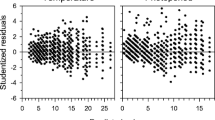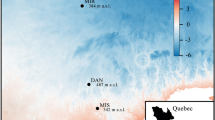Abstract
• Introduction
The annual development cycle of boreal and temperate trees results from an evolutionary trade-off between two opposing forces. These are namely, the adjustment of leaf phenology to the timing of frost occurrence at the beginning and/or the end of the growth season countered by an effective adjustment to the duration of the growth season to maximise photosynthesis and biomass production during the growing season.
• Objectives
In a provenance trial of common beech (Fagus sylvatica L.) populations, we tested whether avoiding frost events by late flushing is the primary process of frost tolerance, and also, whether longer growth seasons resulted in an increase in biomass production.
• Results
We detected clines with altitude and longitude of provenances for phenological traits, in contrast to growth variables. A highly significant negative genetic correlation was detected between frost damage and budburst date which confirms that the timing of leaf flushing is the principal determinant of tolerance to late frost.
Height and diameter growth were positively correlated with the length of the vegetation season. However, this effect was associated with the timing of growth cessation rather than with budburst.
• Conclusions
Stabilizing selection, selective pressure on early leaf flushing of juveniles in dense natural beech stands, and epigenetic regulation of budburst are proposed as explanations for these observations.




Similar content being viewed by others
References
Alberdi M, Corcuera LJ (1991) Cold acclimation in plants. Phytochemistry 30:3177–3184
Augspurger CK (2008) Early spring leaf out enhances growth and survival of saplings in a temperate deciduous forest. Oecologia 156:281–286
Chambel MR, Climent J, Alía R, Valladares F (2005) Phenotypic plasticity: a useful framework for understanding adaptation in forest species. Invest Agrar Sist Recur For 14:334–344
Čiamporová M, Trgiňová I (1999) Modifications of plant cell ultrastructure accompanying metabolic responses to low temperatures. Biologia 54:349–360
Delpierre N, Dufrêne E, Soudani K, Ulrich E, Cecchini S, Boé J, François C (2009) Modelling interannual and spatial variability of leaf senescence for three deciduous tree species in France. Agr Forest Meteorol 149:938–948
Dewald L, White TL, Duryea ML (1992) Growth and phenology of seedlings of 4 contrasting slash pine families in 10 nitrogen regimes. Tree Physiol 11:255–269
El-Kassaby YA, Park YS (1993) Genetic variation and correlation in growth, biomass, and phenology of Douglas-fir diallel progeny at different spacings. Silvae Genet 42:289–297
Estrella N, Menzel A (2006) Responses of leaf colouring in four deciduous tree species to climate and weather in Germany. Clim Res 32:253–267
Falusi M, Calamassi R (1996) Geographic variation and bud dormancy in beech seedlings (Fagus sylvatica L.). Ann Sci For 53:967–979
Fuchs J, Jovtchev G, Schubert I (2008) The chromosomal distribution of histone methylation marks in gymnosperms differs from that of angiosperms. Chromosome Res 16:891–898
Hawkins BJ, Stoehr M (2009) Growth, phenology, and cold hardiness of 32 Douglas-fir full-sib families. Can J For Res 39:1821–1834
Heide OM (1993) Dormancy release in beech buds (Fagus sylvatica) requires both chilling and long days. Physiol Plantarum 89:187–191
Johnsen Ø, Fossdal CG, Nagy N, Molmann J, Daehlen OG, Skrøppa T (2005) Climatic adaptation in Picea abies progenies is affected by the temperature during zygotic embryogenesis and seed maturation. Plant Cell Environ 28:1090–1102
Kindermann J, Wurth G, Kohlmaier GH, Badeck FW (1996) Interannual variation of carbon exchange fluxes in terrestrial ecosystems. Global Biogeochem Cy 10:737–755
Kosová K, Vítámvás P, Prášil IT (2007) The role of dehydrins in plant response to cold. Biol Plant 51:601–617
Kramer K (1994) Selecting a model to predict the onset of growth of Fagus sylvatica. J Appl Ecol 31:172–181
Lechowicz M (1984) Why do temperate deciduous trees leaf out at different times? Adaptation and ecology of forest communities. Am Nat 124:821–842
Leinonen I, Hänninen H (2002) Adaptation of the timing of bud burst of Norway spruce to temperate and boreal climates. Silva Fenn 36:695–701
Li P, Adams WT (1993) Genetic control of bud phenology in pole-size trees and seedlings of coastal Douglas-fir. Can J For Res 23:1043–1051
Loehle C (1998) Height growth rate tradeoffs determine northern and southern range limits for trees. J Biogeogr 25:735–742
Lopez-Matas MA, Nuñez P, Soto A, Allona I, Casado R, Collada C, Guevara MA, Argoncillo C, Gomez L (2004) Protein cryoprotective activity of a cytosolic small heat shock protein that accumulates constitutively in chestnut stems and is up-regulated by low and high temperatures. Plant Physiol 134:1708–1717
Maynard Smith J (1982) Evolution and the theory of games. Cambridge University Press, Cambridge, 224 pages
Mimura M, Aitken SN (2010) Local adaptation at the range peripheries of Sitka spruce. J Evol Biol 23:249–258
Mode CJ, Robinson HF (1959) Pleiotropism and the genetic variance and covariance. Biometrics 15:518–537
Rehfeldt GE (1992) Early selection in Pinus ponderosa – compromises between growth potential and growth rhythm in developing breeding strategies. For Sci 38:661–677
Reyes-Diaz M, Alberdi M, Piper F, Bravo LA, Corcuera LJ (2005) Low temperature responses of Nothofagus dombeyi and Nothofagus nitida, two evergreen species from south central Chile. Tree Physiol 25:1389–1398
Rohde A, Junttila O (2008) Remembrances of an embryo: long-term effects on phenology traits in spruce. New Phytol 177:2–5
SAS (2009) SAS/STAT® User's Guide, http://support.sas.com/documentation/onlinedoc/stat/index.html. Accessed 14 Feb 2010
Schlichting CD (1986) The evolution of phenotypic plasticity in plants. Ann Rev Ecol Syst 17:667–693
Seiwa K (1999) Changes in leaf phenology are dependent on tree height in Acer mono, a deciduous broad-leaved tree. Ann Bot 83:355–361
St. Clair SB, Monson SD, Smith EA, Cahill DG, Calder WJ (2009) Altered leaf morphology, leaf resource dilution and defense chemistry induction in frost-defoliated aspen (Populus tremuloides). Tree Physiol 29:1259–1268
Stushnoff C, Seufferheld MJ, Creegan T (1997) Oligosaccharides as endogenous cryoprotectants in woody plants. In: Li PH, Chen THH (eds) Plant Cold Hardiness – Molecular Biology, Biochemistry, and Physiology. Plenum Publishers, New York, pp 301–309
Vitasse Y, Porté AJ, Kremer A, Michalet R, Delzon S (2009) Responses of canopy duration to temperature changes in four temperate tree species: relative contributions of spring and autumn leaf phenology. Oecologia 161:187–198
von Wuehlisch G, Duval H, Jacques D, Muhs HJ (1995a) Stability of differences in flushing between provenances in different years and at different sites. In: Madsen SF (ed) Genetics and Silviculture of Beech. Danish Forest and Landscape Research Institute, Hørsholm, pp 83–89
von Wuehlisch G, Krusche D, Muhs HJ (1995b) Variation in temperature sum requirement for flushing of beech provenances. Silvae Genet 44:5–6
Acknowledgements
The provenance trial has been established through the realisation of the project European Network for the Evaluation of the Genetic Resources of Beech for Appropriate Use in Sustainable Forestry Management (Contract AIR3-CT94-2091) under the coordination of H.-J. Muhs and G. von Wuehlisch. Collection of field data was accomplished within the COST Action E52 Evaluation of Beech Genetic Resources for Sustainable Forestry. The study was supported by a grant of the Slovak Agency for Research and Development no. APVV-0441-07. The assistance of D. Krajmerová, I. Romšaková, G. Baloghová and H. Parobková with height and diameter measurements is highly appreciated. Weather data for the station Kráľová were kindly provided by K. Střelcová. We also wish to thank to D. Pauleová, E. Ritch-Krc and P. Svihra for language correction.
Author information
Authors and Affiliations
Corresponding author
Additional information
Handling Editor: Luc Pâques
Electronic supplementary material
Below is the link to the electronic supplementary material.
ESM 1
(DOC 1768 kb)
Rights and permissions
About this article
Cite this article
Gömöry, D., Paule, L. Trade-off between height growth and spring flushing in common beech (Fagus sylvatica L.). Annals of Forest Science 68, 975–984 (2011). https://doi.org/10.1007/s13595-011-0103-1
Received:
Accepted:
Published:
Issue Date:
DOI: https://doi.org/10.1007/s13595-011-0103-1




